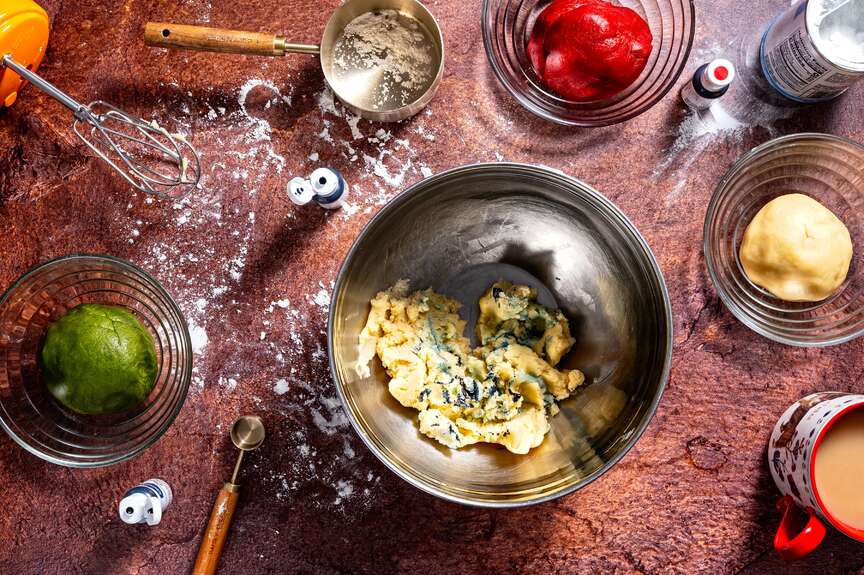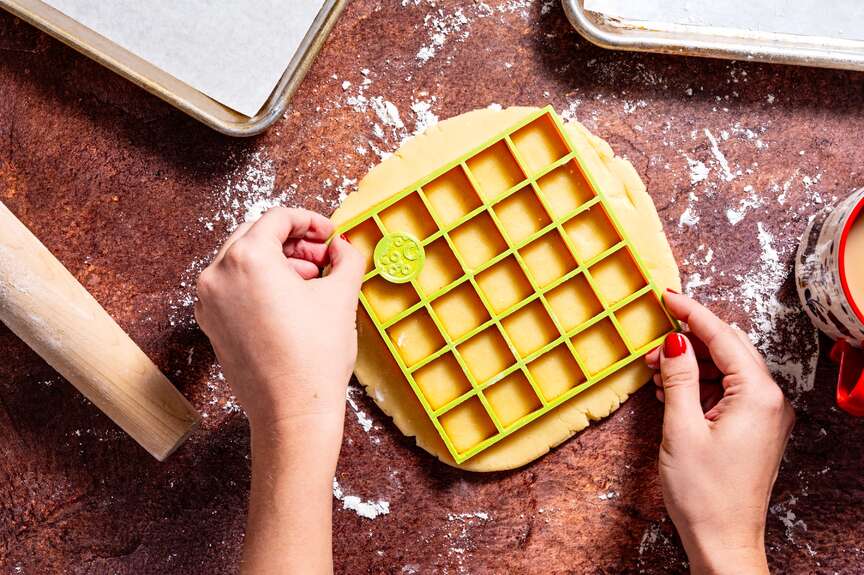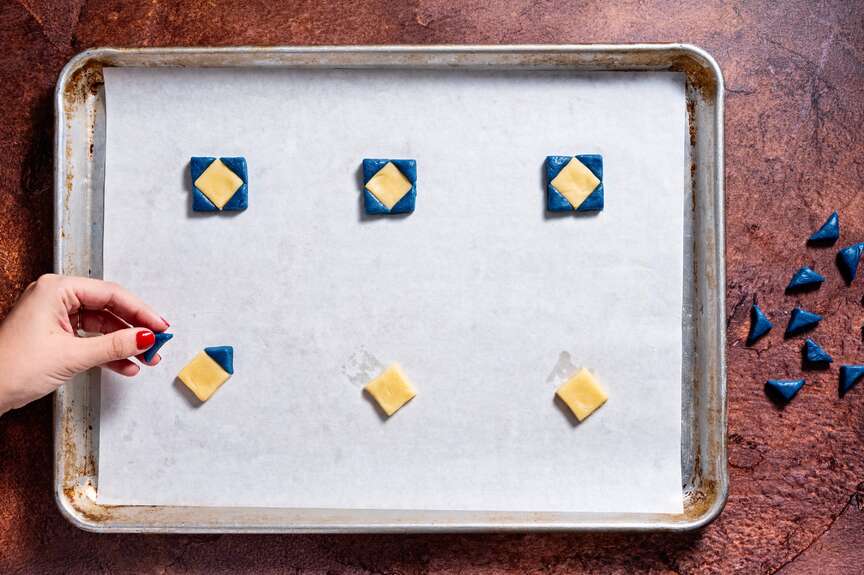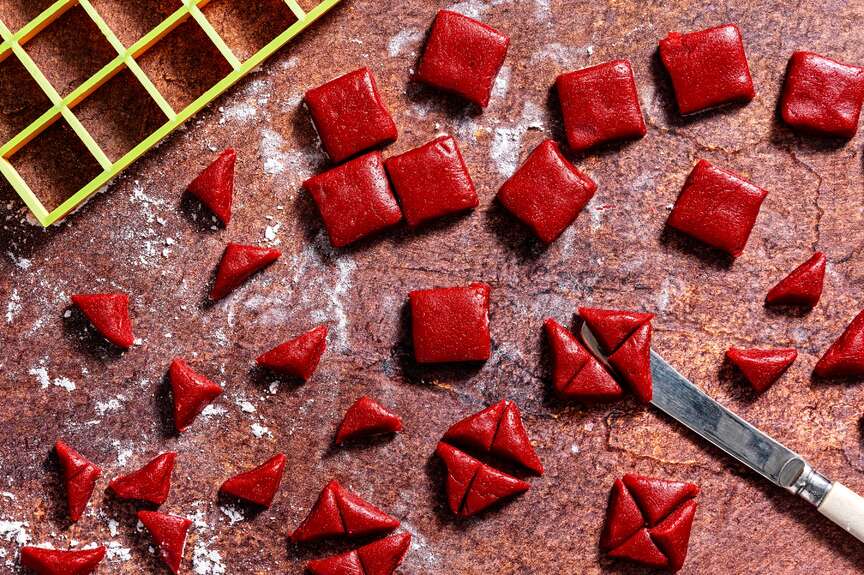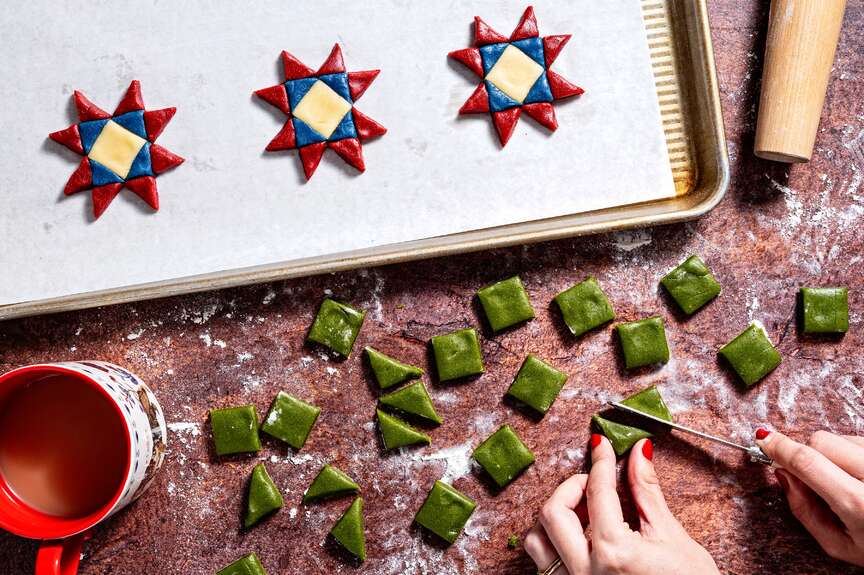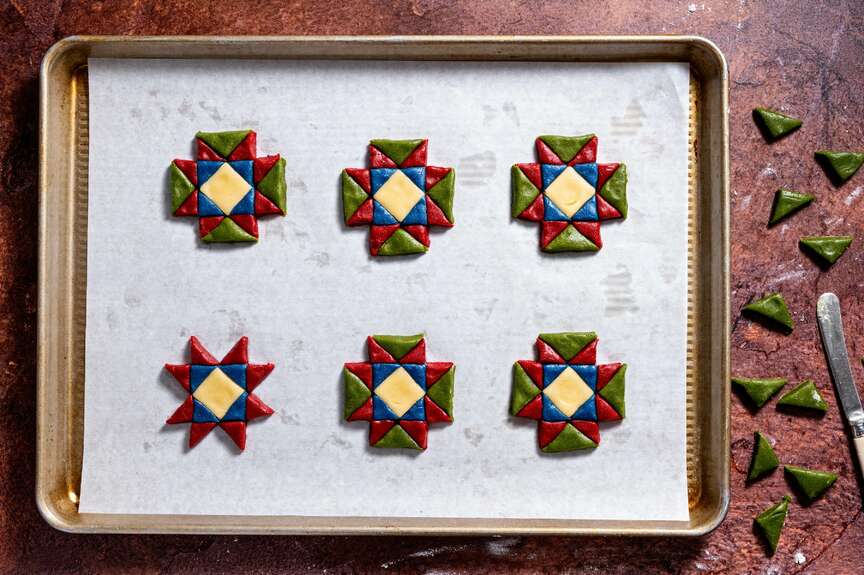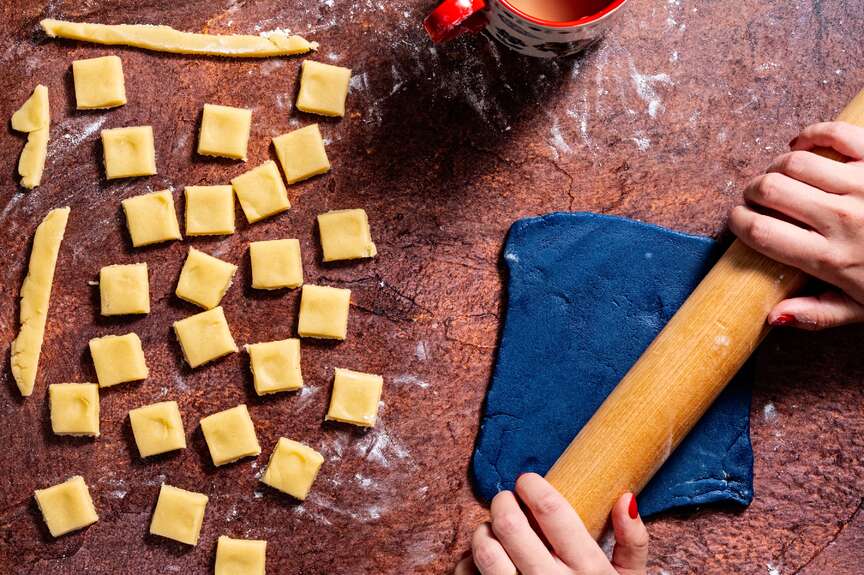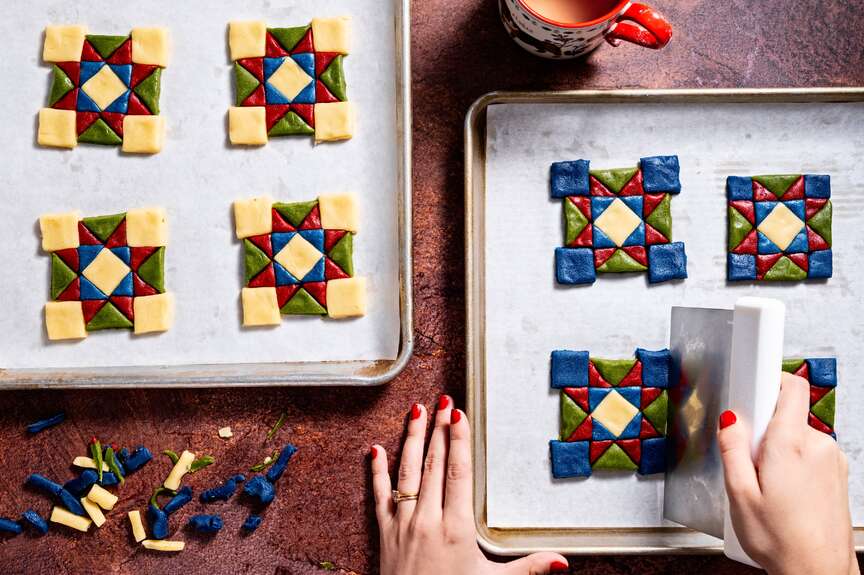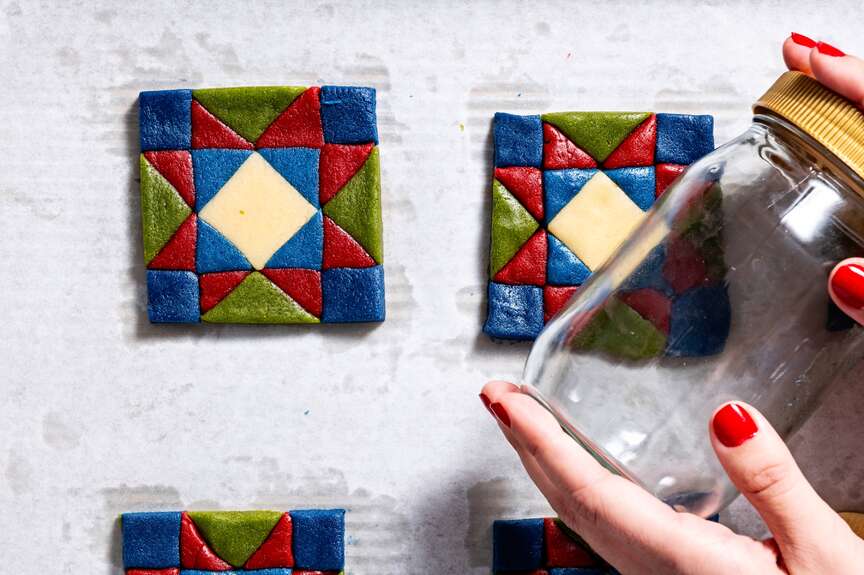I was born and raised in the Appalachian Mountains, where intricate quilts were carefully displayed at local arts fairs or familiarly folded across a friend's family couch. I grew up hearing about beloved ancestors who became storied textile artists and quilters in their day. There's a power and a tenderness to the medium used to comfort and to preserve stories. This recipe became a fun and intimate way to honor the art I grew up around
The spark started last fall, when I was thinking a lot about the playful polymer clay projects I loved as a kid and the colorful canes many artists use to make jewelry. Could I combine those concepts with a slice-and-bake cookie method, similar to classic checkerboard sugar cookies, and layer rows for a patchwork effect? That path was messy and time-consuming, so I tried cutting out each individual shape to form a patch. That method was cleaner and quicker, and it felt like playing with tiles or putting together a puzzle. A classic sugar cookie recipe is perfect for this, as it's malleable and forgiving.
I usually work with a version of the Ohio star quilt pattern, which is geometric and simple, and instantly recognizable. Once you nail the basics, it's easy to make it your own. I've seen parents make these cookies with their kids, and friends swap them at gatherings. Play with your favorite hues, represent your alma mater or just experiment with color schemes.
A simple 1-inch square cookie cutter is the only tool you need to create the pattern of a classic star quilt block. However, a multi-square cookie cutter (a larger square divided into smaller ones) significantly speeds up the process. If you have neither of those, a sharp knife and straight edge will do the trick, though it will take more time. Assemble the cookies directly on the sheet pans, as it's difficult to transport the dough without the block falling apart.
You will probably have leftover dough, but not enough of the different colors for the full pattern. See the recipe for tips on how to use it.
QUILT BLOCK SUGAR COOKIES
12 servings (makes 12 cookies, plus extra from scraps)
Total time: 2 hours 15 mins, plus cooling time
Make ahead: Refrigerate the colored dough portions in an airtight container (or wrapped in plastic wrap) for up to 4 days.
Storage: Store in an airtight container at room temperature for up to 1 week, or freeze for up to 2 months.
Where to buy: Multi-square cookie cutters are available online, including on Etsy. Gel food coloring can be found at well-stocked supermarkets, cake decorating stores and online.
Substitutions: To make these gluten-free >> use 3 cups (417 grams) all-purpose gluten-free flour blend. To make these vegan >> see Variations.
Variations: For vegan cookies, add 2 tablespoons cornstarch and 1/2 teaspoon baking soda along with the flour. Eliminate the egg, and use vegan butter instead of regular butter.
3 cups (375 grams) all-purpose flour, plus more as needed
2 teaspoons baking powder
1/2 teaspoon fine salt
16 tablespoons (2 sticks/227 grams) unsalted butter, softened
1 cup (200 grams) granulated sugar
1 large egg, at room temperature
1 1/2 teaspoons vanilla extract
3 to 4 assorted gel food colorings
Step 1: In a medium bowl, whisk together the flour, baking powder and salt until well combined.
Step 2: In a stand mixer fitted with the paddle attachment, or using a hand mixer and a large bowl, beat together the butter and sugar on medium-high speed, until smooth and somewhat lightened, about 1 minute, scraping the sides and bottom of the bowl and the attachment as needed. Add the egg and vanilla, and beat again on medium-high until combined, 1 minute more. Scrape down the bowl one more time.
Step 3: On low speed, gradually add the flour mixture to the mixer bowl, about 1/2 cup at a time, until almost, but not fully, combined. The dough will look a little dry or crumbly; that's okay. It will finish coming together once you add the food colorings.
Step 4: Divide the dough into four equal portions, about 215 grams each (approximately the size of a baseball), leaving one in the mixer bowl and transferring the rest to small individual bowls. These are the portions for your four colors of dough. You can leave one batch uncolored so the other three colors pop and feel balanced; if you'd like to do that, make the dough still in the mixer bowl the plain batch. Return the mixer to medium-high and beat for 30 seconds, until the dough comes together. Transfer to a small bowl. Working from your intended lightest to darkest color to avoid them bleeding into each other, return one portion of dough at a time to the mixer bowl and add 2 to 3 drops of food coloring, depending on the desired vibrancy. Mix on medium-high until the color is evenly distributed. The dough should be moist but not sticky, and easy to handle. If the dough is too soft or tacky, stir in a little more flour until it comes together. As you work, return each colored batch to the individual bowls.
Step 5: Before you start assembling the cookies, position a rack in the middle of the oven and preheat to 350 degrees. Line 2 large sheet pans with parchment paper.
Step 6: Lightly flour your work surface and a rolling pin. Starting with any color (though the plain dough works especially well), roll out the dough to a thickness of about 1/4 inch. Using either a 1-inch cookie cutter or a larger square cutter that you can break into smaller squares, cut out 12 1-inch squares. (Alternatively, use a ruler and sharp knife, though this may take significantly longer.) This will be the center of your quilt block. Transfer 6 of the squares each to the two prepared sheet pans, with the corners in the north, south, east and west positions so that the square is oriented like a diamond or kite. Keep in mind that you will be building out 3-inch cookies, so leave plenty of space on all sides.
Step 7: Repeat the rolling with a second color of dough, reflouring the work surface and rolling pin as needed. Cut out 12 more 1-inch squares. Slice each square on the diagonal twice (from corner to corner), so that you have a total of 48 small triangles, equal in size. Each triangle will have one long side, and two approximately equal, shorter sides. Building the cookies on the sheet pan as you work, arrange the base (longest side) of each triangle against the four sides of the square. The resulting shape will be one larger square. The dough is fairly malleable, so don't be afraid to manipulate and pinch the pieces as you work to get them into the right size or shape, which will become more apparent as you attach the segments to one another.
Step 8: Roll out a third color of dough. Cut out 24 1-inch squares and cut each square into 4 triangles, as above, for a total of 96 small triangles. These triangles will serve as the "points" of the star. Continuing to build each cookie on the sheet pans, place one of the shorter sides of each triangle against the shorter sides of one of the previous triangles, orienting pairs of triangles on each side of the square so that they form a v-shaped notch. This will create your central star shape.
Step 9: Roll out the fourth and final portion of dough. Cut out 24 more 1-inch squares and slice diagonally (only once this time), resulting in 48 larger triangles. With the longest side facing outward, place each triangle, point down, into the open v-shaped space between the prongs of the stars.
Step 10: To fill in the corners and complete the block, roll out additional portions of your first or second color, or a combination. (This prevents having the same color next to each other in the finished cookies.) For example, you can use your first color for 6 of the cookies, and your second color for the remaining 6. Cut out 48 small (approximately 3/4-inch) squares in the color(s) of your choice and set one into each of the four corners of the cookies. To ensure the sides are even, you can use a 3-inch square cookie cutter to trim the edges, or simply slice with a sharp knife or bench scraper. If you have only a little excess sticking out, you can use the side of a knife or a bench scraper to nudge the dough into a neat square.
Step 11: Gently roll over your completed blocks with a rolling pin or small bottle/jar until all the sections are an even thickness. (Alternatively, gently press with the flat bottom of a dry-ingredient measuring cup until the separate sections are nearly level.) If you need to even back out the sides to create straight edges, repeat the trimming or nudging as described above.
Step 12: Bake one sheet at a time for 7 to 9 minutes, or until the cookies slightly puff and the segments adhere to one another. They may not look firm but will continue to set. If the sides of the cookies are more rounded than straight or slightly uneven, you can use the side of a knife or bench scraper to gently nudge them back into squares as soon as they come out of the oven. Let cool on the pans for at least 10 minutes, then transfer to a wire rack to cool completely.
Step 13: If you have leftover dough, you can make some bonus quilt/checkerboard cookies with fewer colors or shapes. Or make kaleidoscope cookies: Press or stack the scraps together, roll to a thickness of 1/4-inch and cut into any size or shape you like before baking.
Nutrition Per quilt cookie (not including bonus cookies): 212 calories, 27g carbohydrates, 37mg cholesterol, 11g fat, 1g fiber, 3g protein, 6g saturated fat, 120mg sodium, 11g sugar
From food writer Lauren Dozier.


